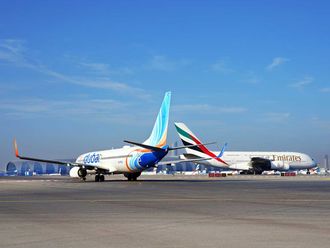
Dubai: Air Arabia is seeing an improvement in Russia and Ukraine, two markets the low-cost airline has significantly scaled back from in recent years due to their economic and political fragility.
Demand for air travel between the UAE and Russia and Ukraine has softened since the end of 2013. Civil war and the shooting down of Malaysian Airlines flight MH17 in Ukraine’s east in 2014 forced many airlines to cut back on flights to the country. Meanwhile, demand in the Russian market has been hampered by a weak economy hit by a 50 per cent drop in oil prices since June 2014 and western sanctions for its role in the pro-Russian unrest in Ukraine.
But the two Eastern European countries are getting better for Air Arabia, it’s chief executive said on Monday. “[The] Russian market is improving, China is doing very well, Ukraine has improved based year-on-year,” Adel Ali told reporters at an aviation industry event in Dubai.
Air Arabia, the UAE’s only listed carrier, along with other Gulf carriers has significantly reduced its operations into Russia and Ukraine in recent years.
According to its website it is currently only flying to Kiev, the Ukrainian capital, and Russia’s capital Moscow. It had once flown to seven destinations in Russia and four in Ukraine.
Ali did not say whether the airline is planning on resuming flights to any of the Russian or Ukrainian cities Air Arabia once flew to.
However, cities in the east of Ukraine are likely to continue to be out of bounds for many carriers due to the region’s instability and destruction of key infrastructure, including Donetsk airport.
China market outperforms
Ali also said the Chinese market is performing above expectations. The airline launched flights to Urumqi in China’s north-west in February 2015.
The Air Arabia CEO said the airline is interested in adding more destinations in China but it is not able to reach those destinations in a single flight with its current aircraft.
The carrier is yet to make a decision on its next aircraft order. It ordered 44 Airbus A320’s in 2007 and will receive the last aircraft in that order list at the end of 2016.
Ali said the airline is in “no rush” to make a decision now.
“When we’re ready, we’ll do it,” he said, suggesting the airline may expand its fleet in 2017 with leased aircraft.
“There are hundreds of leasing companies and sometimes they [offer] better deals,” he said.
He also said the airlines fuel-hedging strategy is paying off for the airline.
In August 2015, Air Arabia reported a 12 per cent drop in second-quarter net profit after yields faced pressure from low oil pries and other factors.
In February, the airline blamed fuel hedging for a 30 per cent fall in fourth-quarter 2014 net profit.
“We should not over emphasise [the fuel-hedging strategy],” Ali said on Monday.
Forty-five per cent of Air Arabia’s 2015 fuel requirements are hedged at $90 (Dh330.57) a barrel, according to an investor presentation slide available on the airline’s website.
Ali also said the airline has not tried to renegotiate its 2016 fuel-hedging strategy. Fifty-nine per cent of its 2016 fuel requirements are hedged at $79 a barrel.
In 2015, the price of global benchmark Brent crude has floated between $45 and $65 a barrel.
In a speech earlier to industry executives, Ali warned that the Middle East market is currently faced with an “irrational” level of capacity that is harming the bottom-line of the industry.
Ali later declined to name which airlines he was talking about.









